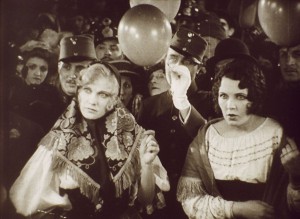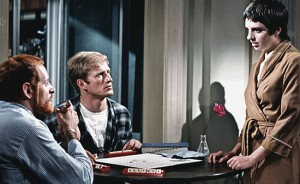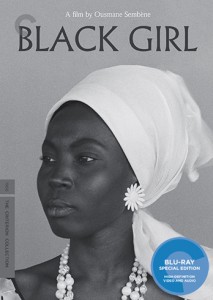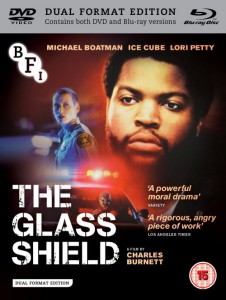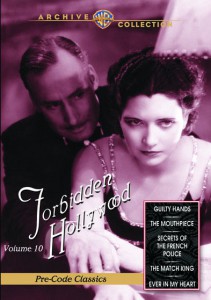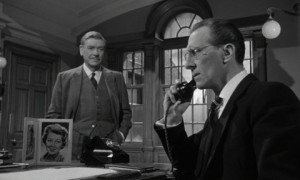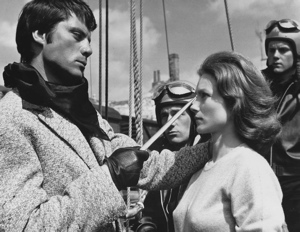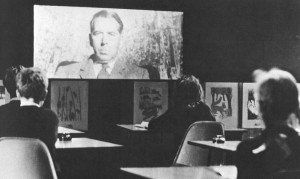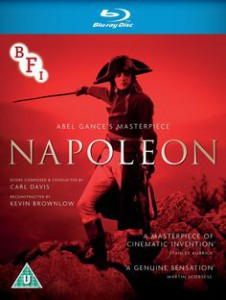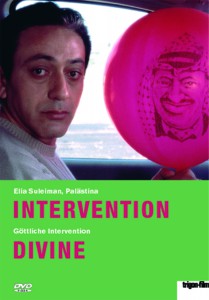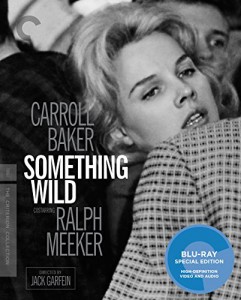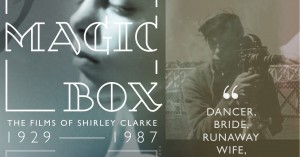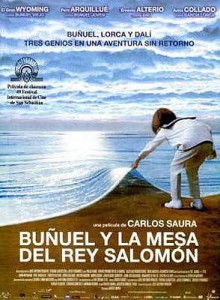My column for the Spring 2017 issue of Cinema Scope. – – J.R.
Probably the most important DVD release of last year, inexplicably overlooked by me when I made out my lists for Sight and Sound and DVD Beaver, is Josef von Sternberg: The Salvation Hunters (1925) and The Case of Lena Smith (fragment, 1929), a single all-region disc from www.edition-filmmuseum.com for 19.95 Euros. It includes a wonderful new 32-minute audiovisual essay on The Salvation Hunters by Janet Bergstrom, and a new score to Sternberg’s first feature by Siegfried Friedrich, but the real pièce de résistance here is the dazzling four-minute fragment from the otherwise lost The Case of Lena Smith, discovered by Japanese film historian Komatsu Hiroshi in a Chinese junk shop in Dalian in 2003. (See the Filmmuseum’s exhaustive 2007 book about The Case of Lena Smith for more details.) In Edgardo Cozarinsky’s 1995 Citizen Langlois, Langlois’ companion Mary Meerson is quoted as saying, “The Case of Lena Smith will reappear one day when mankind deserves it.” In the meantime, here is a fragrant glimpse of what undeserving mankind is missing.
Although most of the recent Blu-Ray releases of Olive Films have tended to steer clear of their previous auteurist commitments, Otto Preminger’s underrated if sometimes problematic 1969 Tell Me That You Love Me, Junie Moon is a very welcome exception. For Foster Hirsch, whom I tend to trust more on the subject of Actors Studio (see below) than on the subject of Preminger, this movie, ‘coming on the heels of Skidoo,’ is ‘a film awash in the kid of sloppy sentimentality Otto had always avoided and the only film in his entire career without a single redeeming feature.’ For me, the first of many redeeming features is Pete Seeger’s unforgettable appearance and performance behind the opening credits, and the movie’s sentimentality, if one wants to call it that, is anything but sloppy; in fact, it’s often mixed with Preminger’s singular brand of perversity as well as his honesty. Chris Fujiwara correctly maintains in his own Preminger biography that the film is as much a countercultural effort as Skidoo, and one could add that it’s even more personal as such.
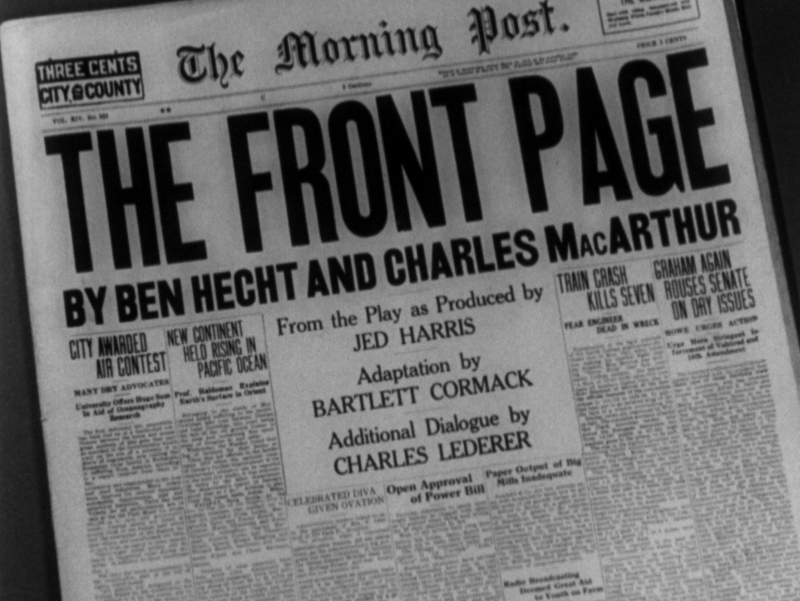
What a great idea it was for Criterion to pair Howard Hawks’ 1940 His Girl Friday in its Blu-Ray edition with its neglected source, released nine years earlier, Lewis Milestone’s The Front Page! My own admiration for the direction and acting in the Hawks comedy has always been checked somewhat by its cruel streak—the sheer heartlessness of the material, which is also apparent in Hawks’ earlier Bringing Up Baby (1938), though it’s arguably less evident in The Front Page. I tend to associate this cruelty with the scary nihilism that lurks around the edges of most Hawks pictures, until it finally comes out front and center in Rio Lobo.
There is also much to be grateful for in Criterion’s Blu-Ray edition of Sembène Ousmane’s Black Girl (1966), most of whose extras either duplicate or approximate those on the recent dual-format BFI PAL edition, meanwhile clearly surpassing those on the now out-of-print New Yorker DVD. A lot of what I’m grateful for ultimately boils down to Sembène’s forceful eloquence, not just as a filmmaker but also as a commentator about his own work and about Africa. Yet there’s one lamentable lapse and absence in all the editions of Black Girl/La noire de…that I’m aware of: the very beautiful short story of his that the film is based on. This is the penultimate story in his collection Tribal Scars (or Voltaique in French) called ‘The Promised Land’. I can’t understand why none of these editions reproduce this 18-page story, and also why there appears to be a tacit understanding among most critics of the film not to discuss its source in any detail. Diawara correctly observes that the beginning of the story is less effective and purposeful than the beginning of the film, and he might have added that the same could be said for the ending—for me, one of the most powerful endings of any film–even though its original form is a very moving poem called ‘Longing’ addressed to the heroine, that enhances and brings further relevance to the film’s radically different coda. As Sembène points out to Manthia Diawara in one of the extras, his own preference is for literature over cinema, but given the greater number of people that cinema reaches, literature becomes a luxury. Yet surely DVDs and Blu-Rays are also luxuries, even compared to books, so why can’t they incorporate the luxury of literature?
For many years, I’ve contended that Charles Burnett was obliged by the Weinsteins to reshoot the ending of The Glass Shield (1994). But as Burnett has recently clarified in an interview on the excellent BFI Blu-Ray edition of the film, this is not what happened. The less harsh ending written and shot by Burnett was done according to his own wishes. For whatever it’s worth, I still find the original ending more powerful, but I can also certainly understand Burnett’s reasons for wanting to tone it down, and whatever his differences with the Weinstein brothers on other matters, he has further suggested that all the final decisions made on the film were his own.
The appearance of Forbidden Hollywood’s Volume 10 from Warners on at least a couple of the ten-best lists on DVD Beaver persuaded me to order it. But now that I’ve seen three of its five features —Guilty Hands (W.S. Van Dyke, 1931), The Mouthpiece (James Flood and Elliott Nugent, 1932), and The Match King (Howard Bretherton and William Keighley, 1932)–with Secrets of the French Police (Edward Sutherland, 1932) and Ever in My Heart (Archie Mayo, 1933, with Barbara Stanwyck) still to go—I’m more than a little puzzled about what made it such a preferred release. The fact that these programmers appear to represent typical early 30s fare might be what’s most interesting about them, and I was intrigued to discover who and what William Warren represented for Depression audiences as a conniving smoothie in The Mouthpiece and The Match King, to be hated and admired at the same time.
It was a tip from James Naremore that directed me to Cash on Demand (Quentin Lawrence, 1961), a snug little Dickensian bank-heist thriller—and fortunately, the DVD package that includes it, Hammer Films: The Icons of Suspense Collection (from Columbia Pictures), is one I already owned thanks to its inclusion of my absolute favorite Joseph Losey feature, the relatively unsung These Are the Damned (1962). (The four other lurid titles in the set — Stop Me Before I Kill! [Val Guest, 1960], The Snorkel [Guy Green, 1958], Maniac [Michael Carreras, 1963], and Never Take Candy from a Stranger [Cyril Frankel, 1960] — sound even more Hammeresque.)
Cash on Demand bears some lamentable resemblance to “A Christmas Carol,” hokeyness and all, but the fact that it all unfolds in something resembling real time makes it more than bearable, and the performances (especially André Morell as a cheerful heistmeister) are a real delight. I also wound up reseeing These Are the Damned for the umpteenth time and enjoying it more than ever. Its sheer audacity in freely mixing clashing moods and genres—biker action + Antonioni seaside artiness + SF + dystopian satire + Macdonald Carey’s pure B-film bemusement + philosophical talkfest + perverse and flirty eroticism (complete with Freudian unpacking)—never ceases to amaze me. Anticipating A Clockwork Orange by a full decade (via Oliver Reed), it also manages to kill off virtually all of its sympathetic characters so that it can end like Aldrich’s Kiss Me Deadly with the end of the world shortly to follow. How much this can be credited to the movie’s obscure source novel or its adaptation by a Jamaican screenwriter awaits further research.
Packaging postscript: The five Hammer films are on three discs, stacked on top of each other in a tidy case—in striking contrast to the poorly attached five discs in Forbidden Hollywood, Volume 10, which tend to slide out of their receptacles every time the case is opened. But this doesn’t mean that Warners always gets packaging wrong: I recently bought TCM’s Greatest Classic Legends devoted to Burt Lancaster—mostly for Jacques Tourneur’s 1950 The Flame and the Arrow, but also to catch up belatedly on Executive Action (1973—a lemon) and Local Hero (1983) and resee Seven Days in May (1964)—and all four, on separate discs, are stacked together flawlessly.
***
Although this column has generally been devoted to reviews rather than notices, my rapidly encroaching travel schedule in mid-January has persuaded me to relax that emphasis a little in order to draw attention to a few releases that I haven’t yet found time to examine in any depth—which also means, in effect, cleaning off some of my shelves.
Foremost among these alerts is Icarus Films’ DVD release of The Seasons in Quincy: Four Portraits of John Berger, shot in the village in the French Alps that Berger moved to from London in 1973. As luck would have it, this came out only a few weeks before the death of the artist-philosopher-writer at age 90. The four portraits in this 2015 feature are by Bartek Dziadosz, Colin MacCabe, Christopher Roth, and Tilda Swinton, mostly working collaboratively with each other on most of the episodes. All four of these people, along with writer Akshi Singh and Berger himself, contributed texts to the accompanying 16-page booklet.
So far, the only time I’ve seen Abel Gance’s Napoléon (1927) was in 1981, when Francis Ford Coppola screened what was then purported to be the ‘complete’ version at Radio City Music Hall. In fact, although this wasn’t widely known at the time, an entire subplot was excised at the time so that the film wouldn’t run past midnight and jack up the theater’s operating costs. So considering the fact that Kevin Brownlow has been trying to reconstruct the original film for most of his life, I’m sure that my second viewing of the film will be the three-disc, region 2 BFI Blu-Ray, which runs for 332 minutes and which Brownlow supervised, as soon as I can find the time. The first edition of this set (which also exists on DVD) has already sold out by now, but I’m told that the second edition will be identical.
The BFI has also released a dual-format edition of Victor Erice’s Sur (1983), with many extras, and Adrian Martin has assured me that one of his all-time best audio commentaries is for the BFI Blu-Ray of Otto Preminger’s Carmen Jones (1954).
In the mid-70s, I was a big fan of James Scott’s experimental English feature Coilin & Platonida, which I reviewed for the Monthly Film Bulletin (https://www.jonathanrosenbaum.net/1976/12/coilin-platonida-1976-review/). More recently, Scott won an Academy Award in 1983 for a short film that adapted Graham Greene, A Shocking Accident, and still more recently, he sent me a DVD of his less experimental fiction feature about his painter father William Scott, Every Picture Tells a Story, made in the mid-80s and available at www.directcinema.com/category/89/578 (or at cheaper prices from Amazon and elsewhere).
I’ve been wondering lately about what’s happened to Elia Suleiman, the talented and highly original comic Palestinian filmmaker and actor. His first feature, Chronicle of a Disappearance (1996), no longer seems to be available, and I haven’t yet caught up with his third, The Time That Remains (2009), although I’ve just ordered a copy on Amazon. But I was specifically interested in reseeing his second, Divine Intervention (2002), and in the course of ordering that as well, I discovered that its distributor—Avatar Films at avatarfilms.com—includes trailers on its web site for all its releases, a list that also includes The Mill & The Cross, Kandahar, and New York in the Fifties (2001). The latter is a 2001 documentary by Betty Blankenbaker that I hadn’t previously known about and which I also ordered—a thoughtful if conventional adaptation of the Dan Wakefield book likely to make anyone who experienced this era first-hand more than a little misty-eyed.
I don’t yet know whether I’ll ever get around to watching Jamil Dehlavi’s epic biopic Jinnah (1998)–about the life (and afterlife) of Muhammad Ali Jinnah, founder of the Muslim nation of Pakistan (and played by Christopher Lee)–but Eureka! in the U.K. sent me its dual format edition some time ago, and its U.K. censors’ seal labels it ‘strong violence, injury detail’. Truthfully, I’m much more likely to open and look at Midas Filmes and the Cinemateca Portuguesa’s Paulo Rocha DVD box set with O Rio Do Ouro (1998) and Se Eu Fosse Ladrâo…Roubavas (2012), both with English subtitles.
Pere Portabella’s General Report (1976) — a monumental account of where Spain stood just after the death of Franco, made shortly before Portabella became one of the drafters of the new Spanish Constitution–is one of his greatest films in his singular and still-neglected oeuvre. The full title, General Report on Some Interesting Facts for a Public Showing, is deceptive only in its modesty insofar as its opening hovers around Franco’s tomb with the funereal gravity of the opening of Citizen Kane. And in fact, though I’ve tended to regard this film as a documentary, Portabella regards it as a fiction film (‘because it’s choreographed,’ as he explained to Jerry White in Cinema Scope 67, Summer 2016—and indeed, the difficulty in distinguishing between fiction and non-fiction in all of Portabella’s films is a major part of what makes them so singular and provocative).
Portabella’s 126-minute 2016 sequel, General Report 2: The New Abduction of Europe, is a bit of a disappointment in terms of what appears to be its relative conventionality, but I need to see it a second time before I can be sure of this. Meanwhile, you can buy a DVD package of both films with English subtitles (as well as Castilian subtitles, plus Catalan subtitles on General Report 2) and a 24-page booklet of texts in Castilian only for 16.71 Euros on Spanish Amazon. The running time given for General Report in this set is 148 minutes—six minutes less than the version available in the box set devoted to Portabella’s so-called Complete Works, which suggests to me some subsequent trimming on Portabella’s part. And pace Jerry White in Cinema Scope 67, the original length was two and a half hours, not three.
Although I haven’t yet managed to resee Jack Garfein’s 1961 Something Wild—an independently made American movie that I frankly hated as a college freshman when it came out, for what I regarded then as its pretentiousness overdose of New York angst—the extras on the Criterion Blu-Ray, all of which I’ve recently seen, have persuaded me to rethink some of my original assumptions about the film. For one thing, Garfein’s background as a Holocaust survivor has radically changed my sense of what the film is about; for another, Garfein’s long-term involvement with the Actors Studio makes some of the extras — especially interviews with Carroll Baker and Foster Hirsch and a video of one of Garfein’s recent lectures about acting—quite fascinating.
***
Before getting around to seeing any more of Milestone’s three-disc Blu-Ray set The Magic Box: The Films of Shirley Clarke, the fourth and final volume of this label’s exemplary “Project Shirley,” after finally catching up with her 1963 Robert Frost: A Lover’s Quarrel with the World, and before reseeing Luis Buñuel’s sublime if grubby 1962 The Exterminating Angel on the new Criterion Blu-Ray, I decide to resee my pirated DVD of my favourite Carlos Saura feature, his scandalously neglected 2001 Buñuel and King Solomon’s Table–a giddy fantasy about Don Luis in his late Jean-Claude Carrière period dreaming up a feature that combines some memories of his youthful times with Salvador Dali and Federico Garcia Lorca in Toledo with a cockamamie fantasy-adventure that begins like an Indiana Jones romp (for which Carrière as an actor furnishes the initial stimulus) and then becomes increasingly more metaphysical and Freudian before ending in giddy incoherence.
I assume that one reason why this hugely enjoyable picture—fitfully available with subtitles from Amazon and ebay, often at exorbitant prices–apparently never acquired much exposure in North America was David Stratton’s review in Variety, which called it “capricious’ and ‘fitfully entertaining’, adding, ‘Buffs will appreciate the in-jokes and references to works by the surrealist master, but for the non-aficionados the film has little to offer. Fests will be eager for a pic stuffed with cinematic riches, but it’s a shame Saura took it all so seriously; a little more of Buñuel’s subversive humor would have gone a long way.’ Personally I found the film hilarious all the way through, at least until the incoherent ending, and I’m pretty sure that Saura and his cowriters (which apparently included Carrière) wanted me to. The portrait of Buñuel (perfectly captured in his dotage by El Gran Wyoming) is affectionately disrespectful, offering comic demythification of a fairly high order; if I ever teach a course on Buñuel, this film would make an excellent inclusion. Furthermore, the dreamlike conceits and attractive décor periodically recall Edgar Neville’s delirious 1944 Tower of the Seven Hunchbacks– fortunately a bit easier to find nowadays.

